
Laurence O'Bryan, founder of BooksGoSocial
Amazon made a variety of welcome changes to their advertising dashboard in 2019. These changes create opportunities and challenges for authors. Laurence O'Bryan, ALLi partner member and founder of ad agency for books, BooksGoSocial, is here to explain the latest Amazon ads dashboard changes and what they mean for you.
Why Run Ads on Amazon at All?
Advertising a book on Amazon is one way to help ensure readers have a chance to see it when they are looking for similar books on Amazon. Most books are simply never seen by readers, as there are now so many on Amazon.
But first, a safety note. Please test Amazon ads with a small daily budget perhaps $2 a day with 3 different ads (campaigns) = $6 total daily budget, but only if you can afford to lose this for a few days or longer.
It can take a week or two for Amazon to start showing your ads, depending on your bids and genre, so if nothing happens in the first few days, please be patient and keep monitoring. The ads can start at any time. They usually start slowly, spending far less than your daily budget, but in some smaller genres the ads start fast and will spend your full daily budget.
So, monitor the results every day to see what your spend is. And monitor your Royalties in your KDP dashboard.
Know your daily spend and your daily royalties. Do not run Amazon ads unless you are able to access this data whether through your own dashboard or from your publisher. Reckoning sales from #ranking is an unreliable exercise. Let’s hope all publishers provide sales dashboards to their authors soon and join the rest of us in the 21st century.
For the basics of how to set up Amazon ads, this free course from Kindlepreneur will help: https://kindlepreneur.com/ams-book-advertising-course/ Dave Chesson, who created this free course, has also recently updated the course to reflect the new Amazon ads dashboard.
If you are familiar with Amazon ads this post covers the key ways authors can take advantage of the updates to the Amazon ads dashboard. These include:
The Search Terms Report
The search terms report provides spreadsheet type data listing the search terms which book buyers used to find your book. You can find the search terms report in the menu on the left in any Ad Group (more on these later) or at the Campaign level depending on the type of ad. See the menu option to click highlighted in yellow below:

The search terms report provides immediate access to 60 days of data. I recommend you download it every 59 days so you don’t lose earlier data.
The following screen grab shows how you can use the data:

The keywords highlighted in yellow all produced sales for this children’s book. If the author had not already used these keywords in ads, they can now add them to an ad to help ensure the book is seen when people search for these or similar keywords or phrases.
Ad Groups
Amazon automatically asks us to create an Ad Group – a subset of one or more ads in a campaign – when we create a Sponsored Product ad using Standard Ad as the Ad Format. This is for ads where you don’t use extra text. That text is what appears in italics in the following screen shot taken at random from Amazon: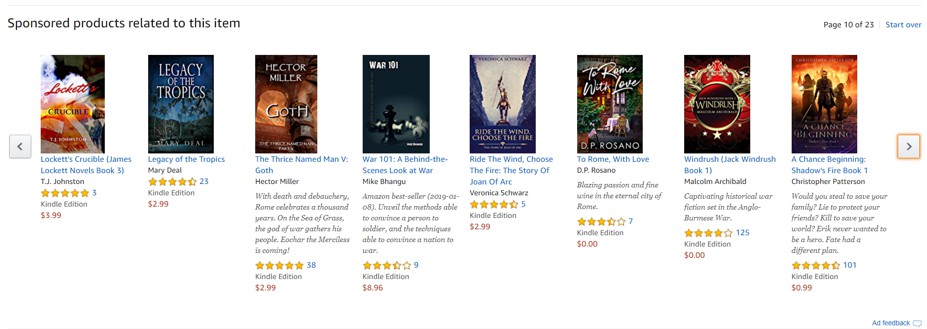 Three of the ads in this strip of ads above, which normally appear in the middle of a book page on Amazon, have no text in italics. These are Standard Ads.
Three of the ads in this strip of ads above, which normally appear in the middle of a book page on Amazon, have no text in italics. These are Standard Ads.
Our research shows that a well crafted sub-title can generate as many sales as those using the text in italics shown above, which are Custom text ads. See Ride the Wind above as an example of a Standard ad. This has “The Story of Joan of Arc,” as a powerful sub-title, at least as effective as the smaller text in italics for many of the other books shown.
The purpose of Ad Groups is to allow us to create multiple ads in one campaign where we can vary the book, the bid type or targeting strategy. This allows for A/B testing within campaigns where we can change one variable on the ad and see the results, while keeping to the maximum daily budget set at the campaign level.
Portfolios
Portfolios is another recent development in the Amazon ads Dashboard. See the portfolios highlighted on the left in the screen shot below for a new author looking to get seen on Amazon:
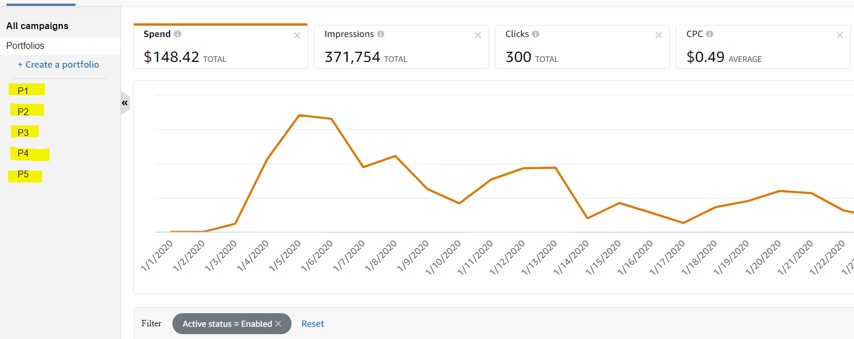
Portfolios allow us to also set a Date Range or Recurring Monthly budget for all campaigns and Ad Groups we place in each portfolio. We do this by clicking Modify Portfolio on the upper right in the portfolio. We then get presented with the following screen, where the appropriate budget cap can be set:
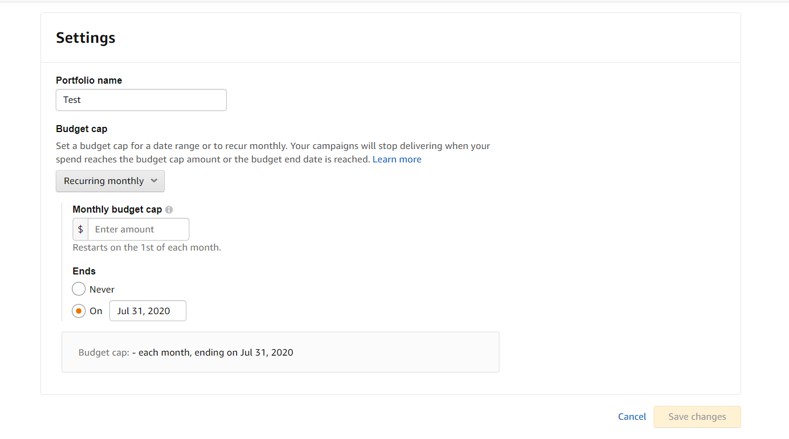
History Report
The history screen allows us to see the impact of changes we make within an AdGroup or at the Campaign level. This data is hugely useful, because previously we had to create spreadsheets with details of the tweaks we made to campaigns to see if they were effective over time. In the screenshot below, the dotted vertical lines, show the dates of changes made by us and when you hover your cursor over the dotted line a pop up appears with the details of the change made.
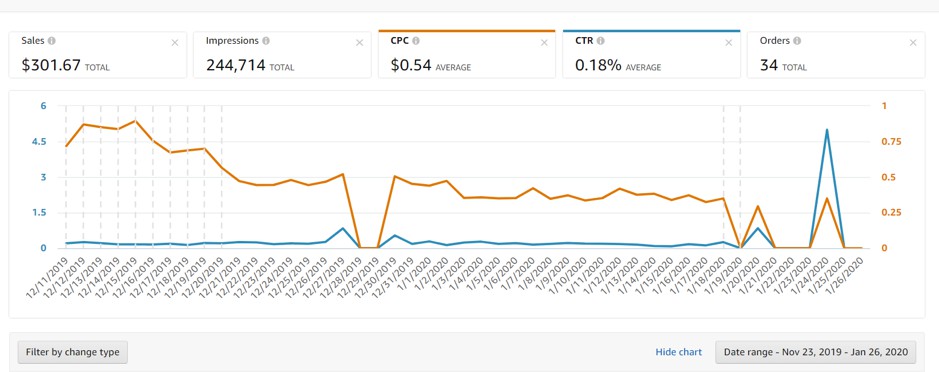
The table below this chart in your Amazon ads dashboard lists all the changes made and can be filtered by change type. Tweaking Amazon ads can be a daily task. Seeing the impact of the changes provides reassurance or a warning about the impact of the changes we make.
Keywords and Bids
Amazon provides additional support when we create Sponsored Product ads. This post does not cover Lock Screen ads, as the key recent Amazon ads changes have been to Sponsored Product ads.
When we create new Sponsored Product ads set for Auto Targeting we now have the option to set the bids by Targeting Group, adjusting the bids for Close Match (highly similar books and related keywords,) Loose Match (somewhat similar books and related keywords,) Substitutes (books that could be a substitute for yours,) and Complements (books and related products that are not similar to yours, where you book would fit well with such a product.)
I suggest adjusting the Close Match upwards by 10% as a first test. We have found that some books do well with upping the bid on Close Match, while other do better with Loose Match upward bidding.
These options allow you to create multiple ads within an Ad Group where you only change one thing, creating an A & B variation to see which sells more books.
When doing Manual Targeting we can now select Broad (showing your book to widely related keywords,) Phrase (showing your book where the Keyword Phrase is similar,) and Exact Keyword usage (where our books only show when someone searches for the exact keyword we entered.) We also have the option to custom bid on each keyword.
Still with me? Where we use Product Targeting we can also search for ASIN’s (Amazon version of your book’s ISBN) and insert ASINs as a target.
These options provide multiple ways to run A/B tests. At BooksGoSocial we have run over 7,500 Amazon ads of every type. In all cases we start with an assessment of the book. The biggest impact for the success of an ad is the book itself and how it is presented.
Lots of great reviews, an amazing cover, an enticing description, these are the cornerstones of success with Amazon ads.
Bidding medium, monitoring daily, testing one ad type, then another is the recommended way to run an Amazon ads program. Not expecting immediate results is important, as is being willing to constantly read and seek out advice from experts.
I hope the above provides food for thought on your Amazon ads journey.
Find out more about Laurence O’Bryan founder of the ad agency for books, BooksGoSocial. He also founded the International Dublin Writers’ Festival held in June each year.

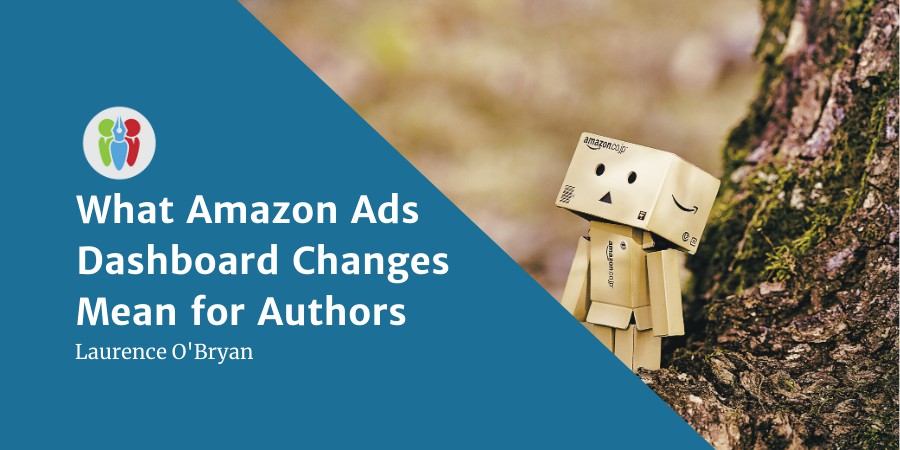
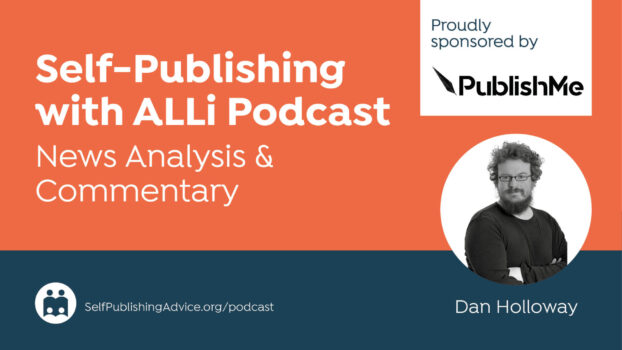


Thank you, Laurence.
I’m going to copy it but I’d rather rely on BGS services when and as I can afford it!
As I will be doing shortly!
Excellent overview! The Search Terms feature was a GAME CHANGER. I wept when I saw the addition. But, I really wish they would allow us to see beyond the past 60 days. In the meantime, I’ll just have to hoard a bunch of CSV files so I don’t miss out on the Search Terms history. Kudos on a well-done post.
Thanks, Laurence.
This post provides direction for writers who are intimidated by the Zon. I’m sharing on my Facebook author page.